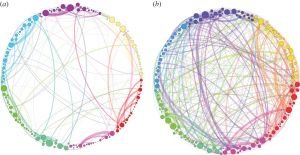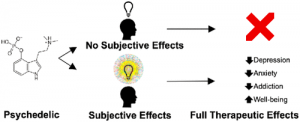Psychedelics
The mind is a neurochemical machine it has so many inputs it evolved the subconscious to stop too much noise overwhelming the system. The word Psychedelic means mind-manifesting, i.e. it is taking some of these subconscious inputs and opening it up to the conscious mind. They work like a switch, once present in the system they switch of the inhibitory system and systems become conscious. The effect is that millions of years of heuristics are opened up. Only those which were promoted to the conscious mind were accessible to you, now you can see what is under the hood. However, as we have a limited awareness i.e. processing power it is different to normal consciousness as all of the inputs which had been subdued are now switch on and you are only built to pay attention to one or two things at one time. So the experience is often incapacitating and thus makes us vulnerable. To deal with this the brain tries to find patterns and groups concepts into "icons", metaphorical symbols, which are being seen from a far. Many of these icons can be archetypal of general human consciousness or personal.
Psychedelic Compounds
There are 5 classes of psychedelics based upon their effect and chemistry.
Tryptamines
- Psilocybin / psilocin found in psilocybin mushrooms
- DMT found in acacias and ayahuasca
- 5-MeO-DMT found in toad venom
Ergoline
- LSD derived from ergot
Phenylethylamines
- Mescaline found in the peyote cactus
- MDMA synthetically made
- 2C-B synthetically made
Deliriants
- Muscimol found in amanita muscaria
- Ibogane
Dissociatives
- Ketamine synthetically made
Psychedelic Comparison
Whilst the pharmaceutical industry markets that psychedelics can cure everything from obesity to hair loss, in reality there is little evidence that they can treat any other conditions apart from mental health issues. In regards to mental health, psychedelics as a group have a very similar effect[1][2][3].
The is a lot of subjective data (for instance see https://erowid.org/experiences/) suggesting that each psychedelic has an individual nuanced effect. However, a recent analysis of 2947 publicly available trip reports concluded:
"MDMA experience reports featured an emotionally intensifying profile accompanied by many cognitive process words and dynamic-personal language. In contrast, Ayahuasca and DMT experience reports involved relatively little emotional language, few cognitive process words, increased analytical thinking-associated language, and the most semantic similarity with psychedelic and mystical experience descriptions[4]. LSD, psilocybin mushroom, and ketamine reports showed only small differences on the emotion-, analytical thinking-, psychedelic, and mystical experience-related language outcomes. Further research has concluded: “Both doses of LSD and the high dose of psilocybin produced qualitatively and quantitatively very similar subjective effects, indicating that alterations of mind that are induced by LSD and psilocybin do not differ beyond the effect duration”[1].
For psilocybin, ketamine, mescaline and LSD it has been found that the psychedelic experience have yielded magnetoencephalographic (MEG) signals values exceeding those of normal waking consciousness. Indicating psychedelic drugs induce ‘heightened state of consciousness‘. The scans found the most notable effects in parts of the brain that are known to be important for perceptions, rather than other roles such as language and movement.
Medicinal Chemistry
All psychedelics are chemically unique and but can be catergorised into four main main types (see figure 2). There are three main families of chemical compounds: tryptamines, phenethylamines, or lysergamides and many tend to act via serotonin 2A receptor agonism which plays a key role in regulation of cortical function.
Side effects
Mescaline causes stomach cramps.
Duration of psychedelic state
- DMT - 30 minutes.
- Psilocybin 3-6 hours.
- Ayahuasca 4-7 hours.
- LSD 6-11 hours.
Duration of effect
Emotions and brain function are altered up to one month after a single high dose of psilocybin[5].
Microdosing
The medical definition of microdosing is a dose given which is sub therapeutic, i.e. does not have any discernible effect. However, thousands of users claim that very low doses of LSD, taken at 3–4-day intervals, improve mood and cognitive function. In control studies, in the absence of placebo, microdosing has been shown to be a figment of imagination many times over in numerous studies[6] This may be due to the fact that the main part of the effect of psychedelics is the subjective effects caused by them, i.e. the experience of the trip is more important than the underlying chemical electrical mechanisms.[7]
References
- ↑ 1.0 1.1 Holze, F., Ley, L., Müller, F. et al. Direct comparison of the acute effects of lysergic acid diethylamide and psilocybin in a double-blind placebo-controlled study in healthy subjects. Neuropsychopharmacol. 47, 1180–1187 (2022). https://doi.org/10.1038/s41386-022-01297-2
- ↑ Carbonaro TM, Johnson MW, Hurwitz E, Griffiths RR. Double-blind comparison of the two hallucinogens psilocybin and dextromethorphan: similarities and differences in subjective experiences. Psychopharmacology (Berl). 2018 Feb;235(2):521-534. doi: 10.1007/s00213-017-4769-4. Epub 2017 Nov 7. PMID: 29116367; PMCID: PMC6645364.
- ↑ Comparison of the Reactions Induced by Psilocybin and LSD-25 in Man, From the National Institute of Mental Health, Addiction Research Center, U. S. Public Health Service, Lexington, Kentucky by HARRIS ISBELL 1959
- ↑ Analysis of recreational psychedelic substance use experiences classified by substance. https://link.springer.com/article/10.1007/s00213-022-06062-3
- ↑ Emotions and brain function are altered up to one month after a single high dose of psilocybin. Barrett, F.S., Doss, M.K., Sepeda, N.D. et al. Sci Rep 10, 2214 (2020). https://doi.org/10.1038/s41598-020-59282-y
- ↑ Repeated low doses of LSD in healthy adults: A placebo-controlled, dose–response study Harriet de Wit,Hanna M. Molla,Anya Bershad,Michael Bremmer,Royce Lee First published: 01 February 2022 https://doi.org/10.1111/adb.13143https://onlinelibrary.wiley.com/doi/abs/10.1111/adb.13143
- ↑ The Subjective Effects of Psychedelics Are Necessary for Their Enduring Therapeutic Effects: David B. Yaden and Roland R. Griffiths* ACS Pharmacol. Transl. Sci. 2021, 4, 2, 568–572. Publication Date:December 10, 2020. https://doi.org/10.1021/acsptsci.0c00194


